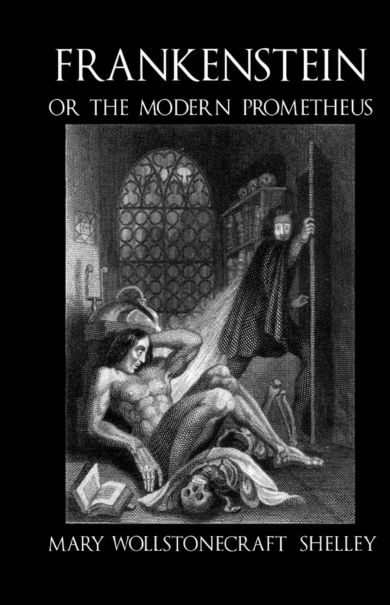
The autumn weather outside naturally encourages us to slow down. Misty mornings and early dusk create a specific atmosphere that favours reaching for literature requiring a bit more focus, or sometimes – offering an escape to entirely different worlds.
When considering what to read in November, it is worth paying attention to titles that correspond with the mood of this month: slightly melancholic, encouraging reflection, but also mysterious. In today’s selection, we have prepared three books for you: from a fundamental classic of horror, through moving non-fiction, to monumental science fiction.
This series is not sponsored. The only criterion for awarding the nominal Books Factory seal of quality is the subjective value of the publications themselves.
A Return to the Roots of Horror: “Frankenstein”
If you associate November with a gothic atmosphere, there can be only one choice. Mary Shelley’s novel is a work that, despite having premiered over two hundred years ago in 1818, still shocks with the relevance of its questions regarding the boundaries of science and a creator’s responsibility for their creation.
Modern publishers continue to present readers with this masterpiece, ensuring the original prose remains accessible to contemporary audiences. The story begins when an ambitious scientist, Victor Frankenstein, obsessively searching for the secret of life, constructs a being from fragments of human bodies. Terrified by the result, he abandons the “monster”.
Contrary to pop-culture imagery, this is not a mumbling beast, but a tragic figure. His sensitivity and intelligence are highlighted by the fact – often omitted in adaptations – that the creature learned to read and understand the world through Goethe’s “The Sorrows of Young Werther”. It was this reading that shaped his pain of rejection and romantic perception of reality.
Why is it worth reaching for this title right now?
- Film context: It is the perfect moment to read the original, as a new, high-profile adaptation directed by the visionary Guillermo del Toro has just debuted. It is worth knowing the original source material before seeing his interpretation on the screen.
- Atmosphere: Descriptions of raw Alpine landscapes and dark laboratories fit the November aura perfectly.
- Depth: This is not a cheap scare story. It is a philosophical treatise on loneliness and the need for acceptance.

A Lesson in Hope in the Hardest Times: “Man’s Search for Meaning”
November is also a time of contemplation and reflection on existence. In this category, it is hard to find a more important title than “Man’s Search for Meaning” by Viktor E. Frankl, a perennial classic in psychology and memoir.
Viktor Frankl, a Viennese psychiatrist, was sent to concentration camps during World War II. In his book, however, he does not focus solely on describing atrocities, but analyses the psychology of the prisoner. Frankl comes to the conclusion that the most powerful driving force is the striving for meaning.
However, this reading can shake the reader not only with hope. The author shares a devastating, personal conclusion at one point: “the best of us did not return”. This sentence brutally realises that survival in the camp often required behaviours whose moral weight the survivors carried for the rest of their lives, while the most noble perished first.
This is mandatory reading because:
- It gives perspective: Daily problems pale in comparison with the author’s experiences.
- It is the foundation of logotherapy: The book accessibly introduces the secrets of a school of psychotherapy based on the search for a purpose in life.
- It is concise: It is an essay of less than two hundred pages with a powerful emotional charge.

An Epic Journey into the Unknown: “Hyperion”
For those who prefer to escape Earth as far as possible on November evenings, we propose an absolute classic of science fiction literature. “Hyperion” by Dan Simmons, the first part of a tetralogy that redefines the concept of space opera, remains a benchmark for the genre.
The action takes place in the face of an impending galactic war. Seven pilgrims set off for the titular planet to reach the mysterious Time Tombs. Each of them tells their story, making this book a literary homage to “The Canterbury Tales”.
Among these narratives, the story of the scholar Sol Weintraub resonates particularly strongly. It is a painful, futuristic travesty of the biblical parable of Abraham sacrificing his son – this thread, full of a parent’s helplessness in the face of a child’s suffering, can bring tears even to fans of hard sci-fi.
“Hyperion” is the ideal proposal for long nights:
- Cult status: This work has been waiting for years for a worthy screen adaptation. Although film plans (linked, among others, with Bradley Cooper) appear regularly, realisation remains questionable – recently also due to controversies surrounding the radical political views of Simmons himself.
- Frame story structure: Each tale is a separate literary genre, which means the book never bores for a moment.
- Edition quality: Hardback editions and attention to editorial details make this title an ornament to any library.

The Power of the Physical Book
Reading the titles above, it is hard to resist the impression that the reception of literature depends not only on the content but also on the form. A solid, hard cover of “Hyperion” or an atmospheric cover of “Frankenstein” make autumn evenings with a book almost a ritual.
As print enthusiasts, we always look with appreciation at editions where attention to paper, typography, and finishing goes hand in hand with outstanding content. It is precisely such details that ensure the paper book still has an advantage over the digital file – it allows one to physically feel the genre weight of the story.
